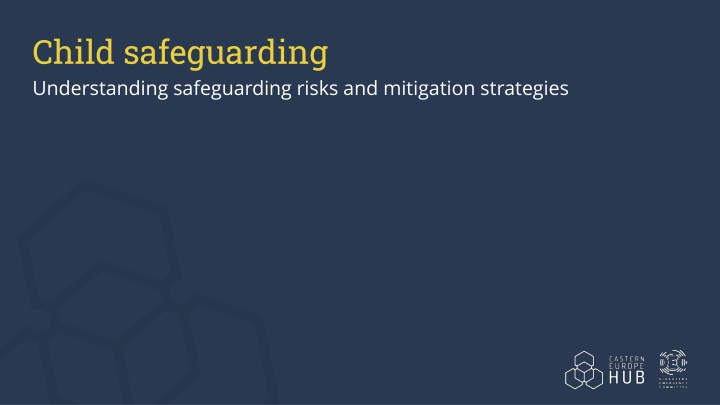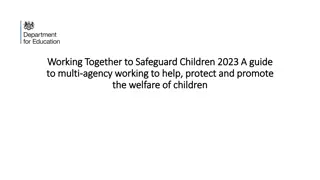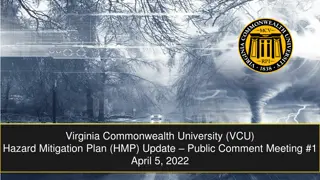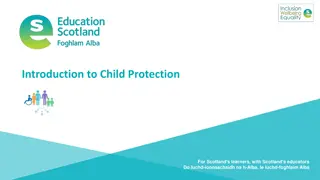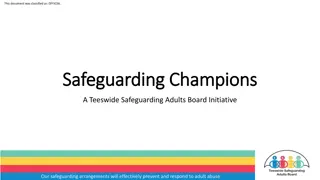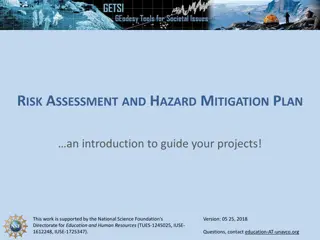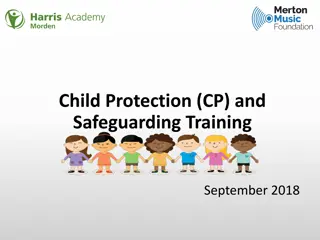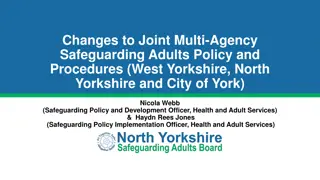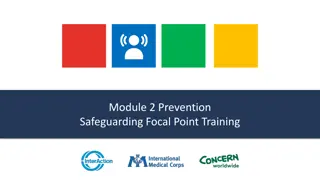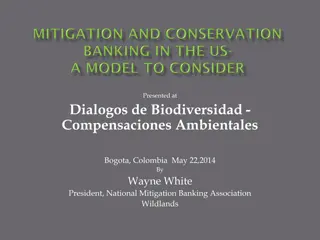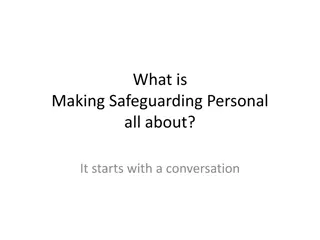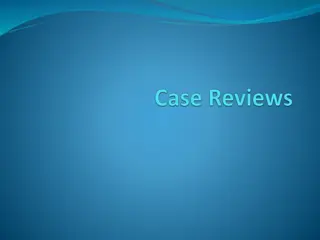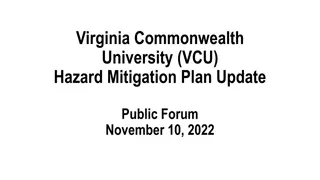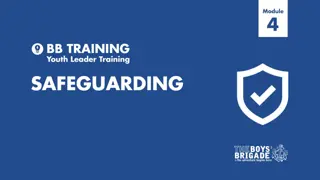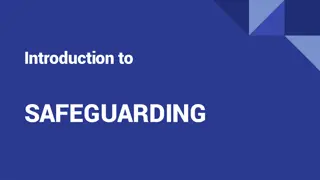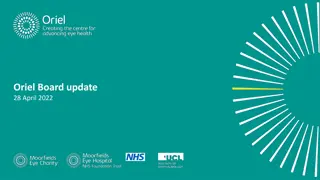Understanding Child Safeguarding Risks and Mitigation Strategies
Understanding child safeguarding risks and mitigation strategies is crucial for organizations to prevent harm to children. This includes identifying who in an organization has contact with children, understanding different forms of abuse, and implementing safeguarding measures. Safeguarding involves taking all reasonable steps to protect children from harm and responding appropriately when harm occurs. Child protection aims to ensure children's rights are protected and they are safeguarded from abuse, violence, neglect, and mistreatment.
Download Presentation

Please find below an Image/Link to download the presentation.
The content on the website is provided AS IS for your information and personal use only. It may not be sold, licensed, or shared on other websites without obtaining consent from the author.If you encounter any issues during the download, it is possible that the publisher has removed the file from their server.
You are allowed to download the files provided on this website for personal or commercial use, subject to the condition that they are used lawfully. All files are the property of their respective owners.
The content on the website is provided AS IS for your information and personal use only. It may not be sold, licensed, or shared on other websites without obtaining consent from the author.
E N D
Presentation Transcript
Child safeguarding Understanding safeguarding risks and mitigation strategies
Objectives of the session: To understand key terms and definitions regarding safeguarding/child safeguarding, standards, procedures. To identify the different ways in which an organisation comes into contact with children even when children may not be the primary focus. To identify who in an organisation has contact with, access to or impacts on children. To deepen understanding of child safeguarding risks and mitigation strategies.
Agenda Session 1: Your organization safeguarding risks (90 mins) Session 2: Your mitigation strategies (90 mins)
What is safeguarding? The Safeguarding Hub Eastern Europe understands safeguarding as taking all reasonable steps to prevent harm from occurring both to the recipients of aid and to people delivering it, and responding appropriately when harm occurs. Keep people safe from sexual exploitation, abuse, sexual harassment, and other forms of harm caused by the misuse of power. Address harm caused by the organization's staff, associates, operations, or programs.
Child Safeguarding The responsibility of organizations to ensure they do no harm to children. This means doing all they can to prevent exploitation and abuse, and if abuse occurs, to respond appropriately. All actions on child safeguarding should be taken in the best interests of the child or children (KCS).
What is child abuse? 1. When a child is harmed by an adult or another child, either intentionally or accidentally in a one-off incident. 2. When a child is harmed by an adult or another child, over a long period of time, either intentionally or accidentally. 3. When an action or lack of action causes harm to a child or has the potential to cause harm to a child.
Different forms of abuse and harm: physical abuse, emotional abuse, sexual abuse and exploitation, neglect.
What does child protection mean? 1. Making sure that children s rights are protected. 2. Making sure that children are protected from all forms of abuse, violence, neglect and mistreatment. Note: Child safeguarding is one aspect in the child protection field. It focuses on situations where harm is caused in the delivery of humanitarian assistance and development.
Child protection and child safeguarding Do No Harm. Children should know what abuse is. Child-friendly reporting procedures in place. Respond to concerns about a child identified as experiencing or likely to experience harm. Child Child Safeguarding: Making NGOs/CSOs safe for children Protection: Making the world safe for children
What are the implications of the different forms of harm? 1. The impact, or likely impact on the child s well-being and development. 2. The act carried out by the perpetrator/person alleged to have been the abuser. 3. Near miss reports discover failings in the organization s operations that could have breached the Child Safeguarding policy but where no child has come to harm as yet.
What does risk mean in the context of safeguarding? 1. Likelihood = the probability of the event occurring 2. Impact (or seriousness as you use) = how severe the harm could be for an individual or the organisation. Note: Due to their age and development status children may be at high risk of harm. Other characteristics, such as race, nationality or disability, will also have impact on the risks the child is facing.
Working groups: understanding the risks in the organisational context Safeguarding risks encountered in the organization context can be grouped in three main categories: programmes, people, operations.
What is a safeguarding concern or incident? Any situation where a child has been harmed or may be harmed in the delivery of aid or development work. Any situation where the CSO s Child Safeguarding Policy (and procedures) have not been followed.
Reporting mechanism/Procedures Think global, act local measures in local context Flow chart for raising concerns is displayed and in child friendly language. Clear procedures and roles and responsibilities Risk assessment and risk mitigation
PSEA and SEAH PSEA: The term is used by the UN and INGO community to refer to measures taken to protect people from and respond appropriately to sexual exploitation and abuse by their own staff and associated personnel targeted at community members (PSEA Implementation Quick Reference Handbook). Sexual abuse: Actual or threatened physical abuse of a sexual nature, which may take place by force, coercion, violence or in situations of inequality, hierarchical relations or a breach of trust. Sexual exploitation: Any actual or attempted sexual abuse of a person in a position of vulnerability, trust or where there is a power differential including, but not limited to, profiting financially, socially or politically from the sexual exploitation of another.
Definitions continued Victim or survivor: A person who is, or has been, sexually exploited or abused. For the purposes of this policy, this is a person who has been sexually abused or exploited by a person bound by a contract with the organisation. Sexual Harassment: A continuum of unacceptable and unwelcome behaviours and practices of a sexual nature that may include, but are not limited to, sexual suggestions or demands, requests for sexual favours, and sexual, verbal or physical conduct or gestures, that are or might reasonably be perceived as offensive or humiliating.
Reflection questions for the case studies exercise 1. Are there any safeguarding concerns that you can identify in the below case studies? 2. If yes, what are these concerns (risks identified etc.)? 3. If no, why there are no concerns?
Scenario 1 Your organization is organizing a summer camp with refugee children in another city. Volunteers, acting as chaperones, are accompanying the children while they are away from home. After the conference an anonymous report reaches the organisation that one of the volunteers abused a child during the summer camp.
Scenario 2 Mr Baker is one of your organisation s most generous and oldest sponsors. Over the years he has visited several of the children he has supported. Your organisation hears he has been questioned by police in the UK about possessing abusive images of children. He recently paid for a child he supported, who is now an adult, to visit him.
Scenario 3 Your organisation produced a publication for supporters, which featured a photo and story about a girl and her family who were having difficulties in their village. The girl and family had given permission for the story to be published. The week following publication project staff tell you that community leaders, who saw the publication online, were angry and have driven the girl and her family out of the community.
Group work Group 1: Programmes Group 2: People Group 3: Operations
Topics for group work 1. How often the organisation has contact with children/beneficiaries? 2. What is the type of contact and by whom? Staff, volunteers? 3. Who are the children/beneficiaries with whom you have more contact? 4. What is their age? Are they with other children? Are they with other adults?
Key Learning points Realizing how much contact an organization has with children, particularly when they are not the primary focus. How contact with children can be made via the internet, and other forms of social media, through letters, and by phone. Even without direct involvement with children, we can have an impact on them.
List of organisational functions Management Financial Management IT Product service delivery Human Resources Developement Programme/Project management Volunteer management Governance and planning Fundraising
Working group 1. List all the risks you possibly can think of linked that might be encountered by children (programmes and people and operations (blue). 2. Rank the level of risks as below: High: highly likely to happen and have significant impact on a child (orange). Medium: either highly likely to happen or has significant impact on a child (yellow). Low: less likely to happen and has less of an impact on a child (green). 3. List the strategies to mitigate those risks (pink).
Risk areas People Programmes Operations What is the programmers impact on children? How do you recruit staff? What services you provide targeting children and families? Do you conduct reference checks? Are the programme activities contextualised ? Have you considered the different needs of children depending on their gender? What level and type of contact this person has with children? Is there any mitigation strategy to address the risks faced in programme implementation ? Are they volunteers or full-time staff? How were those services designed? Are risks assessments being undertaken regularly? Do you have orientation training on safeguarding?
Standards Standard 1: Policy Standard 2: People The organization develops a policy that describes how it is committed to preventing and responding appropriately to, harm to children. The organisation places clear responsibilities and expectations on its staff and associates and supports them to understand and act in line with these.
Standards continued Standard 3: Procedures Standard 4: Accountability The organisation creates a child-safe environment through implementing child safeguarding procedures that are applied across the organization The organisation monitors and reviews its safeguarding measures.
Key learning points: There are often a range of strategies that can be used to manage risks Most risks can be reduced or managed effectively by having in place a Safeguarding Policy, Code of Conduct, Reporting mechanisms. Where it is difficult to reduce or manage risks, organizations need to consider whether the level of risk is acceptable before continuing with the programme or activity.
Key learning points Risks will vary by organisation, context, programme and who you are working with. Risks might arise throughout a programme, risk management is not a one- off activity. Due to their age and development status, children can be at high risk of harm in development work.
Safeguarding: what does it mean? This is a little story about four people named Everybody, Somebody, Anybody, and Nobody. There was an important job Somebody had to do and it was Everybody s job to make sure it got done. Anybody could have done it, but Everybody thought Somebody was doing it, so in the end Nobody did it. Everybody got angry when Nobody did what Somebody was supposed to have done. Everybody thought that Anybody could do it, but Nobody realized that Anybody wasn't doing it. It ended up that Everybody blamed Somebody when Nobody did what Anybody could have done.
Further training Online courses - Keeping Children Safe
Contact information About the Safeguarding Resource and Support Hub Eastern Europe: The RSH EE is funded by the Disasters Emergency Committee (DEC). This resource has been produced as part of the Safeguarding Helpdesk service. For any further request or enquiry, contact easterneurope@safeguardingsupporthub.org.
